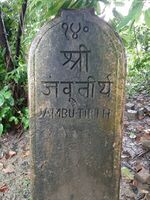Jamvanta
| Author: Laxman Burdak IFS (R) |

Jamvanta (जाम्वन्त) is a bear in Hinduism and believe to lived from Krita Yuga to Dvapara Yuga. He is also considered King of bears and first son of Brahma, before humans were created. Jambavan was present when the churning of the ocean took place and was supposed to have circled the world seven times.
Variants
- Jambanta (जाम्बन्त)
- Jamvanta (जाम्वन्त)
- Jambavanta (जाम्बवन्त)
- Jambavan (जाम्बवान)
- Jambavat (जाम्बवत)
- Jambutirtha (जम्बूतीर्थ)
- Jambavanteshvara (जाम्बवन्तेश्वर)
Mythology
Jambavantha had killed a lion, who had acquired a gem called Syamantaka from Prasena after killing him. Krishna was suspected of killing Prasena for the jewel, so he tracked Prasena's steps until he learned that he had been killed by a lion who had been killed by a bear. Krishna tracked Jambavantha to his cave and a fight ensued. After twenty-one days, realizing who Krishna was, Jambavantha submitted. He gave Krishna the gem and also presented him his daughter Jambavati, who became one of Krishna's wives.
In the epic Ramayana, Jambavantha helped Rama find his wife Sita and fight her abductor, Ravana. Later, it is he who makes Hanuman realize his immense capabilities and encourages him to fly across the ocean to search for Sita in Lanka.
History
Jâmbavat (जाम्बवत) is a holy place name mentioned in (V. 14) of Sarkho Plates of Ratnadeva II - Kalachuri year 880 (1128 AD). Jâmbavat, where the great-grandfather of Padmanâbha fasted himself to death, was a tïrtha. It is perhaps identical with the Jambutirtha (जम्बूतीर्थ) mentioned in the Padmapurâna[1]where there was a Siva-linga called Jambavanteshvara (जाम्बवन्तेश्वर) which is said to have been established by the lord of bears Jambavant, who helped srî-Râmachandra. From the context it appears to have been somewhere in the vicinity of the river Svabhramati (स्वभ्रमती) (modern Sabarmati साबरमती). [2]
Mention by Panini
Jambava (जांबव), is mentioned by Panini in Ashtadhyayi. [3]
Jambavativijaya (जांबवतीविजय), is mentioned by Panini in Ashtadhyayi. [4]
Animal depiction of warriors
When Rama besieged Lanka, all his supporters like Kishkindha king Sugriva and his commander Hanuman, Jatayu, Jamvanta etc were Jat warriors. Bhaleram Beniwal has pointed out that these characters have been depicted as monkeys or animals is out of jealousy of the manuvadis and agents of dharma who never wanted to bring the true history of Jats. [5]
The Jat hostorian Thakur Deshraj has explained about the reasons of animal depiction of people prevalent in India during Ramayana period. During this period all four varnas had come into existence in Aryans. The duties of each varna were defined but they could change varna. Brahmans had come into a dominant position and had full control over kings and the society. Some kshatriyas like Kartaviryarjuna had become rebellions against the increased influence of Brahmans. In Sarswati ashrama a big organization under the leadership of Parsurama was constituted by Brahmans to penalize such kshatriyas. Brahmans suppressed kshatriyas like Kartaviryarjuna and deprived these kshatriyas from their status. The Aryans by this time had crossed Vindhyas and moving towards south. Vanars were inhabitants in southwest Vindhyas. Pampa sarovar was their main center. Vanars were not monkeys but either aboriginal inhabitants of that area or people of Aryan groups who had come from Iran via Bombay and reached south of Vindhyas. [6]
Jamthun village
- Jamthun (जामथुन) - Jamthun village in Ratlam tahsil in Ratlam district in Madhya Pradesh, located in northwest of Ratlam city, has traces of ancient habitation. It is known as the city of Jamvanta (जाम्वन्त) or Jamvanta Nagari. Ancient bricks have been found in excavations. There need for further excavation.[7]
See also
References
- ↑ Uttarakhanda, adhyaya, 150
- ↑ Corpus Inscriptionium Indicarium Vol IV Part 2 Inscriptions of the Kalachuri-Chedi Era, Vasudev Vishnu Mirashi, 1955, p.423-429
- ↑ V. S. Agrawala: India as Known to Panini, 1953, p.ll9
- ↑ V. S. Agrawala: India as Known to Panini, 1953, p.22
- ↑ Bhaleram Beniwal: Jāt Yodhaon ke Balidān, Jaypal Agencies, Agra 2005 (Page 40-41)
- ↑ Thakur Deshraj: Jat Itihasa (Hindi), Maharaja Suraj Mal Smarak Shiksha Sansthan, Delhi, 1934, 2nd edition 1992 (Page 15-19)
- ↑ Dr Ajit Raizada: Art, Archaeology and History of Ratlam, Sharada Prakashan Delhi, 1992, ISBN 81-85320-14-4, p.115
External links
- Jambavantha motivating Hanuman for the task of leaping the ocean. in Valmiki Ramayana - Kishkindha Kanda in Prose Sarga 65 - Accessed Augest 14 2006.
- Story of Syamantaka from www.tirumala.org - Accessed Augest 14 2006.
Back to The Ancient Jats

